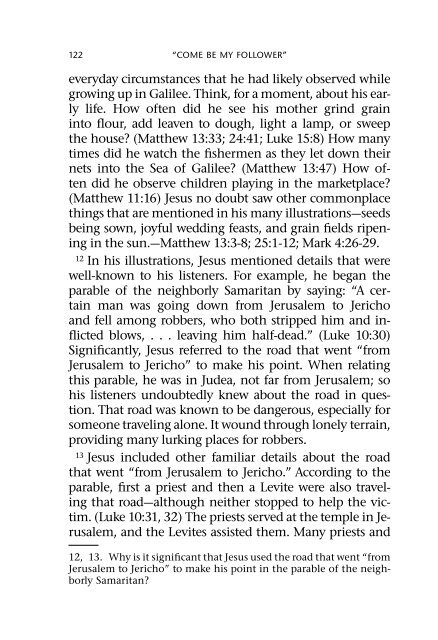Come Be My Follower - Jehovah's Witnesses Official Media Web Site
Come Be My Follower - Jehovah's Witnesses Official Media Web Site
Come Be My Follower - Jehovah's Witnesses Official Media Web Site
You also want an ePaper? Increase the reach of your titles
YUMPU automatically turns print PDFs into web optimized ePapers that Google loves.
122<br />
“COMEBEMYFOLLOWER”<br />
everyday circumstances that he had likely observed while<br />
growing up in Galilee. Think, for a moment, about his early<br />
life. How often did he see his mother grind grain<br />
into flour, add leaven to dough, light a lamp, or sweep<br />
the house? (Matthew 13:33; 24:41; Luke 15:8) How many<br />
times did he watch the fishermen as they let down their<br />
nets into the Sea of Galilee? (Matthew 13:47) How often<br />
did he observe children playing in the marketplace?<br />
(Matthew 11:16) Jesus no doubt saw other commonplace<br />
things that are mentioned in his many illustrations—seeds<br />
being sown, joyful wedding feasts, and grain fields ripening<br />
in the sun.—Matthew 13:3-8; 25:1-12; Mark 4:26-29.<br />
12 In his illustrations, Jesus mentioned details that were<br />
well-known to his listeners. For example, he began the<br />
parable of the neighborly Samaritan by saying: “A certain<br />
man was going down from Jerusalem to Jericho<br />
and fell among robbers, who both stripped him and inflictedblows,...leavinghimhalf-dead.”(Luke10:30)<br />
Significantly, Jesus referred to the road that went “from<br />
Jerusalem to Jericho” to make his point. When relating<br />
this parable, he was in Judea, not far from Jerusalem; so<br />
his listeners undoubtedly knew about the road in question.<br />
That road was known to be dangerous, especially for<br />
someone traveling alone. It wound through lonely terrain,<br />
providing many lurking places for robbers.<br />
13 Jesus included other familiar details about the road<br />
that went “from Jerusalem to Jericho.” According to the<br />
parable, first a priest and then a Levite were also traveling<br />
that road—although neither stopped to help the victim.<br />
(Luke 10:31, 32) The priests served at the temple in Jerusalem,<br />
and the Levites assisted them. Many priests and<br />
12, 13. Why is it significant that Jesus used the road that went “from<br />
Jerusalem to Jericho” to make his point in the parable of the neighborly<br />
Samaritan?






